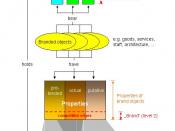The Analysis of Brand Identity, Brand Position
and an IMC Strategy for UK Market Penetration:
The Case of Burt's Bees
Module Name: Marketing Communications (26322)
Student ID: 200616470
Lecturer: Dr. Wen-ling Liu
Date of submission: 10th December, 2007
Word Count: 3808
Content
21. Introduction: �
22. Brand Identity �
32.1 Physique �
42.2 Relationship �
42.3 Customer Reflection �
52.4 Personality �
62.5 Culture �
72.6 Self-image �
73. Brand Positioning �
94. IMC Strategy �
94.1 IMC Strategy �
124.2 Communication Mix �
165. Conclusion �
17Appendices �
18Reference �
��
The Analysis of Brand Identity, Brand Position
and an IMC Strategy for UK Market Penetration:
The Case of Burt's Bees
1. Introduction:
Burt's Bees has become a strong personal care company in USA after over 20 year's development. It is praised for its natural personal care products and has taken up big market share in USA.
In order to extend to global market, the company penetrates UK market, however, it encounters the problem that UK customers do not know its products so that the turnover is low. Burt's Bees needs to make some improvements aiming to solve the problem. This report analyses Burt's Bees's brand identity, discusses its poisoning, and develops an integrated marketing communications (IMC) strategy for the UK market penetration.
2. Brand Identity
Integrated marketing communications (IMC) is a way of looking at the whole marketing process from the viewpoint of the receiver (Kotler, 2000:549). It emphasises the two-way communications between a company and its customers by the association with various media. From the whole marketing perspective, as Chris Fill argued, IMC integrates promotional tools, messages, marketing mix, branding, strategy, employees, technology, and agencies (Fill, 2005). Branding is an important element, because the brand of a company is the abstract image of its...



Wanted a little bit more comparison
but enjoyed your clear concise approach
0 out of 0 people found this comment useful.